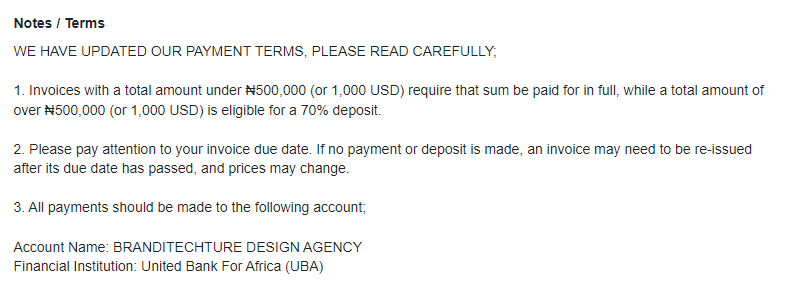This is one of the rarest articles you will ever find on our blog. Why? Because Branditechture is a branding and website design agency and basically shouldn’t be giving advice to competitors, big or small. However, we have decided to break our standard operating procedure this one time just to make an impact in the lives of aspiring website developers who are looking to achieve their dreams of making a living out of the business of website design.
My name is Yusuf Odukoya, I am the founder of Branditechture Design Agency. I have been in the web design business since 2014 when I founded my first company, Schwartz Bacher Systems, but it took a long time for me to figure out what I needed to know.
I made a lot of mistakes when I first started out and I came close to closing my business several times in the process, but in 2019, I finally got things right. I re-entered the web design business with a new point of view, and that was how Branditechture was born. Ever since then, it has been a smooth sail.
In this article, I would share all the tips that will help you stay afloat in the business of website design. These were the lessons learnt from starting my first website design business in late 2014.
1. Stop calling yourself a freelancer
You’re not a freelance web designer, you are a small business owner!
By referring to yourself as a freelancer, you are limiting your entrepreneurial potential. Even if you plan to remain a one-man show, establish yourself as a structured business.
Get a business name and logo, enlist on the CAC registry. Issue invoices and track payments like big companies do. All these would create the needed impression to command the respect that you deserve.
In addition to that, promote and market your business like a pro.
A business such as Branditechture, is treated with more respect than a freelancer. That is a proven fact. People see freelancers as disposable commodities, and they perceive them as such.
2. Build a portfolio
If you’re very new to the business of web design, you’ll need to start with a portfolio. Take projects for a lower price or even for free to build your portfolio faster.
Don’t be afraid to contact the owner(s) of a website that receives a lot of traffic but appears to be outdated. Ask if they want a redesign, work with them at a ridiculously low price. If you do an excellent job, they will gladly allow you to add a small link on their website footer, or even thank you on their website, Facebook Page, or elsewhere.
Most people can reach you through that link if they like the job you did for them.
If you have never had a good-paying client before, you should start attracting them with a portfolio. A portfolio helps to convert visitors into admirers, and admirers into clients.
I did a rebrand in 2020, redesigned my website, and made my portfolio more visible.
My web design portfolio is located on my website’s sticky nav menu. When I get calls from new web design prospects, about 20% of them say something along those lines “We noticed you made this and this website, it’s fantastic, and we’d like something similar “.
This alone increased my conversion rate by about 5%.
Your portfolio does not necessarily have to contain all your works. It should contain only your best works — no matter how few.
3. Always request upfront payment
Before you begin working on anything, you must first be paid. When I just started, I had a lot of clients who would order a project and then disappear.
You’ll get a lot of “we decided we don’t need a website after all”, and your hard work will be for nought. You won’t lose good clients if you demand a 60% upfront payment; you’ll only lose bad clients, which is a good thing for you and your business.
It’s fine if they decide they don’t need a website in the middle of the process. You will keep half of the money and will never have to deal with them again.
When a client pays at least 60% upfront, it becomes in their best interest to complete the project as soon as possible. They won’t say things like “we’ll continue next month” or some similar baloney, and the project will be completed faster.
I personally request 100% upfront payment for small projects. (Projects below ₦500,000 NGN or $1,000), but you can be more lenient as directed above. If in doubt, just have a look at my own payment terms;
Subscribe for updates

4. Learning to write proposals can change your life
A proposal is a document that lists all of the project-specific services you provide to a particular client.
1 year of website hosting, 3 months free website maintenance, a unique website template, a payment processor integration, 2 contact forms, 3 custom emails — Your job is to list the price as well as everything you have to offer, or as required by the project in view. The proposal is sent to the prospect, who then confirms his or her acceptance.
By sending a proposal, you are automatically in a good position to avoid all the extra work that a client may want you to do for free.
Throughout the web design process, many clients demanded more and more from me, and many 8-hour projects turned into 4-month nightmares. If I had always submitted a proposal, then I’d have had the chance to politely decline whenever the client requests something extra during the design process.
Nowadays, the best I can do is to first complete the project according to the proposal’s specifications, and then once the project is completed, I will then create a new proposal and upgrade the website the way they want it.
Don’t do free edits under any circumstances. In business, there are no friends, and clients will smell your weakness of being available for all kinds of free extra work.
I offer 2 months of small edits after the project is completed in my proposal. During this time, the client can contact me and request minor changes, such as a larger font here or a different phone number in the footer, and so on.
You have to know the difference between a minor change and a major upgrade.
For example, when a client says “I also want a newsletter and email opt-in feature,” this is not a minor change, and it’s something I’ll charge extra for.
After the 2-month period is up, I don’t touch the site again unless the client subscribes the website to a Website Maintenance plan.
Back then, I had about 8 clients bugging me every month, with requests for additional work on the site, but I no longer give room for that.
5. Not all clients are meant for you
Not every client is right for you, and there are a lot of clients who are a pain in the neck.
If it appears that the client will only bring you problems, you should most likely decline their services. When you’re in a tight spot and every dollar counts, it’s difficult to say no, but trust me, you’re better off without some clients.
6. Do not design websites without a direction
Whenever I get a new client, I ask them to complete the website design onboarding form, so that I can figure out which direction I should go.
Back then, I built a lot of websites without any direction. They were very good sites, a few clients were wowed, but most clients would typically say something along the lines of “It looks good, but I don’t think it accurately reflects who I am. I’d like images of tulips and roses, and the site should be green and orange”…
7. Don’t start working on any project until you’ve gathered all of the necessary information
I had some clients who would send me 20% of the content they needed for their website and tell me to start working on it right away.
I did my best with what they gave me, and it took weeks, if not months, for them to send the rest of the information, so I couldn’t complete the project as planned. This completely disrupts my workflow, and I would usually end up getting stuck with such clients for many months.
My advice for you is that you collect all the content needed to finish the project from beginning to end.
8. Never underestimate a project
When clients present their requirements, the project appears to be very simple. However, there are always minor issues that can easily double or triple the number of working hours required to complete the project. Consider those hours and don’t underestimate your work. Underestimating your work leads to underpricing.
My fee for creating a website is now roughly three times what it was when I first started. What I noticed was that the clients improved as well.
Clients with the lowest prices always have the highest demands, and you’re better off without them.
Talking from experience, clients with healthy purchasing power are often aware of the process and understand that you are not their friend who will work for free.
9. Fixed pricing doesn’t always work
Most clients expect a fixed price for everything, but that isn’t how pricing works in the world of website design.
I’m currently working on a website for a client who requested a custom website template for their site. You should expect that to cost more vs using a premade website template due to the number of extra manhours that would need to go into it.
Every web design project is unique, and so are the requirements and costs.
10. Prioritize long-term partnerships
You create a website, the client pays, and that’s the end of it. Short-term success comes from hit-and-run tactics, but long-term success comes from long-term partnerships. Offer a fixed monthly fee for backups and maintenance, hosting services, or anything else that will keep the small payments coming in from the same client.
Do you have any other services to offer? Are you looking for SEO or advertising? It gets even better. Offer those as a bonus once the project is completed.
11. Collaborate with a marketer
In the last year and a half, I’ve worked with several marketers who charge around 25% commission on average. Last week, one of them brought me an additional three clients. I get the majority of my clients through referrals from existing clients, but forming partnerships with enough marketers to bring in new clients would allow me to completely worry less about days with no jobs to work on.
Have I missed anything? Comment below if you have any additions or questions.
Are you learning Website Design? You can actually get in front by learning from my book titled “WordPress & Elementor for Absolute Beginners”. It costs only ₦6,000 NGN (less than $15) and it is available worldwide. Click the image below to buy.






